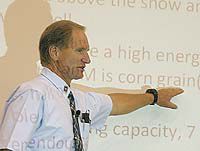| Randy Wiedmeier shares tips on feeding cattle through the winter. |
Great alternatives to feeding livestock through the winter
Randy Wiedmeier, Utah State University ruminant nutritionist, presented a workshop at the Castle Country Economic Summit which focused on ideas to reduce winter feeding costs of livestock. “Feeding the cow herd during the winter months has always been problematic for many farmers and ranchers. Feeding of mechanically harvested feeds is common. Snow precludes grazing,” said Wiedmeier.
Winter feeding can account for one-quarter to one-third of the cost of raising livestock. Droughts necessitate off ranch feed requirements. Low quality feeds are feeds which contain less than 6 percent crude protein and less than 45 percent digestible matter. They are deficient in phosphorous, trace minerals and vitamins.
To calculate the cost to feed livestock, a rancher must compare the cost per ton of feed to the percent of crude protein to find the cost per unit of energy. Each of the winter feeds, cereal straw, grass hay and alfalfa hay have differing amounts of crude protein. This will help determine the number of pounds each animal should receive daily to thrive during the winter. The cost should be kept to 50-60 cents per animal per day.
For a low protein feed such as cereal straws, supplements can be added but raise the cost. Low protein forage plus the supplements are usually less in cost than higher quality forage such as alfalfa hay alone.
Another alternative is to ammoniate low quality forage. To ammoniate feed, the forage stack must be totally enclosed in plastic and then the anhydrous ammonia is injected into the plastic capsule. This process costs about $17 per ton, plus the cost of the forage.
Ammoniation increases digestibility from 40 to 45 percent and crude protein from 4 percent to 8 percent, although it does not increase the vitamin and mineral content. Even after ammoniation, it is not a stand alone feed and supplements must be added.
There is not much difference between treated and supplemented cereal straw and medium grass hay in either cost or nutrition. Ranchers and farmers must be aware that ammoniation cannot be done to forages greater than 5 percent crude protein and 45 percent digestibility or a toxicity will result. Also, ammoniated cereal straws can be used efficiently for lactating cows and replacement heifers.
Grazing corn is a silage corn that is grown and not harvested. During the winter months, livestock can be allowed to graze the corn. One advantage is that it is standing corn and will not cover with snow.
Although the rancher or farmer must be conscious of the number of rows which are available to the cows. Electric fence can be erected between the rows to limit the amount of feed accessed by the livestock. If livestock overeat this forage, the result will be grain overload which may very likely result in death of the animals. The digestibility of this forage is 65 percent.
With several experiments conducted by Wiedmeier, this system of feeding lower the cost of winter feeding substantially, but ranchers and farmers should know that calf weight at weaning time will be slightly lower than on other feeds.

